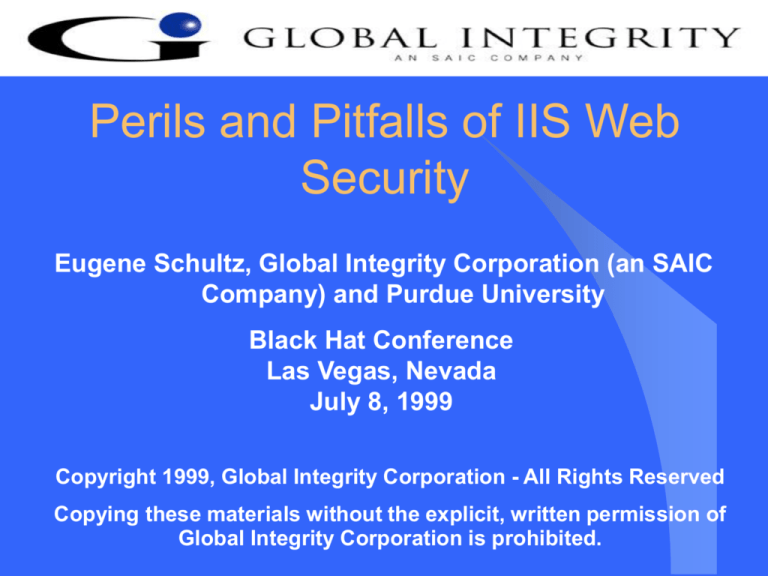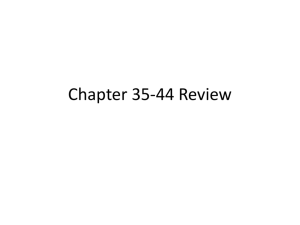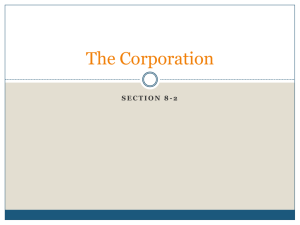
Perils and Pitfalls of IIS Web
Security
Eugene Schultz, Global Integrity Corporation (an SAIC
Company) and Purdue University
Black Hat Conference
Las Vegas, Nevada
July 8, 1999
Copyright 1999, Global Integrity Corporation - All Rights Reserved
Copying these materials without the explicit, written permission of
Global Integrity Corporation is prohibited.
Agenda
Introduction
Vulnerabilities
Solutions
Conclusion
Copyright 1999, Global Integrity Corporation
2
Surprise, surprise?
25 June 1999: Federal Computers Vulnerable
“According to federal officials, federal websites and
computer systems are particularly vulnerable to
outside attacks because they lack two important
elements: adherence to security plans and qualified
personnel to maintain security measures.”
http://www.newspage.com/cgi-bin/NA.GetStory?story=h0624132.500
&date=19990625&level1=46510&level2=46515&level3=821
Copyright 1999, Global Integrity Corporation
3
About the IIS Web server
Very widely used Web server package
Main advantages
Price
Ease
of development and maintenance
Server itself can be implemented using
CGI
ISAPI
ASP
Copyright 1999, Global Integrity Corporation
4
A related component---Front Page
Supports development and maintenance of
Web pages
Consists of
Explorer
(client side)
Editor (client side)
Server
Server Extensions (for managing and referencing
HTML pages)
FrontPage “Bots” perform tasks such as
automatically creating a table of contents
Copyright 1999, Global Integrity Corporation
5
IIS Web authentication*
Basic authentication---to determine
identification and rights of client
First check--to see if user is anonymous
If
anonymous access fails, server sends back information
about other types of authentication that are available
If user is authenticated, server determines whether user’s
credentials are sufficient to allow access to resources
Second--challenge-response authentication
If
anonymous access fails, IIS will normally attempt
challenge-response authentication
Last resort--cleartext authentication
* - Most events that occur are transparent to users---exception, when the
type of authentication used requires users to enter a usernamepassword sequence
Copyright 1999, Global Integrity Corporation
6
MSV1_0 authentication
4. Retrieval of
entries from
SAM
database
1. Authentication request
5. Encryption
of nonce
2. 8-byte
nonce
SERVER
6. Comparison
of encrypted
nonces
3. Encrypted
nonce
CLIENT
Copyright 1999, Global Integrity Corporation
7
Choosing IIS Web authentication
WWW Service Properties for EXCELSIOR
X
Service Directories Logging Advanced
Connection Timeout:
600
seconds
Maximum Connections 1000
Anonymous Logon
Username
Password
Password Authentication
Allow Anonymous
Basic (Clear Text)
Windows NT Challenge/Response
OK
Copyright 1999, Global Integrity Corporation
Cancel
Apply
Help
8
Basic IIS access control methods
Authentication
Limited execution environment
NTFS permissions
Internet Service Manager settings
Copyright 1999, Global Integrity Corporation
9
Exposures in IIS Web services
Incompatibility of authentication schemes
drives cleartext authentication as the
common denominator
Web users are authenticated either as local
users or domain users
Local
access short circuits many security controls
Unauthorized access to Web server can result in
unauthorized domain-wide access
IIS runs as SYSTEM
Copyright 1999, Global Integrity Corporation
10
Exposures in IIS Web services
Buffer overflow conditions abound
IUSR_Servername account is created either
in a domain or on a member server of an IIS
Web server
ASP page access is not properly limited
Front Page vulnerabilities allow a variety of
undesirable outcomes, including
Unauthorized,
privileged access to Web server
Ability to remotely read and write to any file
Denial of service
Copyright 1999, Global Integrity Corporation
11
Exposures in IIS Web services
Vulnerabilities in Active Server itself can
result in a wide range of undesirable
outcomes from a security perspective
Denial
of service
Ability to modify Web page content
Ability to read and/or alter files that are not part of
the Web server
Bots may allow unauthorized reads/writes of
Web page content
Most Web servers themselves are not wellwritten from a security perspective
Copyright 1999, Global Integrity Corporation
12
Example 1
A potential buffer overflow condition in the
ISAPI extension ISM.DLL (a filter used to
process .HTR files) allows
Someone
to crash IIS by sending a long argument
(FORMAT: GET /[overflow].htr HTTP/1.0)
Execution of rogue code
Version affected: IIS 4.0 (SPs 4 and 5)
Problem: lack of proper bounds checking
Solutions: Apply hot fix, or remove the script
mapping for .HTR files from ISAPI.DLL
Copyright 1999, Global Integrity Corporation
13
Example 2
A bug allows anyone to use a default .asp
page to view and also to modify source code
by requesting a file from a virtual directory
(simply enter ../)
Problem: normal processing of the file is
circumvented
Several variants of this bug exist
Found in IIS 3.0 and 4.0
Patch is available (but best solution may be
to remove all default .asp pages)
Copyright 1999, Global Integrity Corporation
14
Example 3
A bug allows CGI scripts that require
authentication to be run without any
authentication
Version affected: IIS 3.0
Is really more of a limitation in an intended
security feature than a vulnerability
Upgrade to IIS 4.0
Copyright 1999, Global Integrity Corporation
15
Example 4
Someone can discover the path to a virtual
directory
Requires only connecting to the
“msdownload” directory at a site, then
pressing Refresh/Reload
Can facilitate an attacker’s efforts to locate
resources to attack
All versions are affected
No patch available yet
Copyright 1999, Global Integrity Corporation
16
Example 5
A malformed GET request can crash IIS,
causing data corruption
Requires that more than one virtual server
run on one machine
Problem: quitting inetinfo.exe by one server
fails to produce a file handle for TEMP files
that the other needs for data writes
Problem is robust across different releases
Hot fix (see Q192296) available
Copyright 1999, Global Integrity Corporation
17
Example 6
An unprivileged user can create an ISAPI
extension to load rogue CGIs that run as
SYSTEM
GetExtensionVersion()
Default()
Applies to any Web server that supports
ISAPI extensions
Exploit code posted widely over the net
All versions are affected
Solution: do not allow users to load CGIs
Copyright 1999, Global Integrity Corporation
18
Example 7
An anonymous user can use NetBIOS
mechanisms to remotely reach
\%systemroot%\system32\inetsrv\iisadmpwd
(virtual directory /IISADMPWD) to start up
HTR files
Passwords
can be changed without authorization
Information about accounts is readable
Best solution is debatable
Delete
/IISADMPWD?
Filter traffic bound for TCP port 139?
Copyright 1999, Global Integrity Corporation
19
Example 8
An unauthorized user can access cached
files without being authenticated
Requires that
More
than one virtual server run on one machine
Both servers have the identical physical and virtual
directory for each target file
This bug is found in all versions of IIS
Problem: failure to recheck credentials after
a cached file is initially accessed
Solutions: Allow only one virtual server on
any machine, or disable caching
Copyright 1999, Global Integrity Corporation
20
Example 9
IIS may fail to log successful HTTP requests
Requests include
File
name
Default.asp
Request method (the attacker must make this very
long---at least 10140 bytes)
May be found only in particular releases (e.g.,
IIS 4.0 server that was upgraded)
No suitable solution so far, but try installing
IIS 4.0 instead of upgrading from IIS 3.0
Copyright 1999, Global Integrity Corporation
21
Example 10
Under certain conditions, calling one or more
ASPs may cause 100% CPU utilization
\exair\root\search\advsearch.asp
\exair\root\search\query.asp
\exair\root\search\search.asp
Default exair page and the DLLs it references
must not be in memory
Best solution: delete \exair and everything
below it
Copyright 1999, Global Integrity Corporation
22
IIS-specific Web security measures
Consider running a Web server that does not
run as SYSTEM
Run the most recent version of IIS Web server
Avoid running IIS on domain controllers
Ensure that the IUSR_<servername> account
has a strong password
Dedicate Web-accessible volumes to HTTPbased access
Copyright 1999, Global Integrity Corporation
23
IIS-specific Web security
measures
Use Internet Service Manager to set
access permissions (read and/or write)
Ensure that Front Page extensions have
appropriate NTFS permissions
Avoid Active Server implementations
when security needs are higher
Use Active Server only to access a
Microsoft transaction component (i.e.,
don’t put code in Active Server itself)
Copyright 1999, Global Integrity Corporation
24
IIS-specific Web security measures
Consider enabling IP filtering
Disable the NetBIOS layer of networking
Use SSL, HTTP-S, or PCT to encrypt sessions
It is generally best to deploy IIS as an internal
Web server
Patch, patch, patch...
Copyright 1999, Global Integrity Corporation
25
Placement of external IIS servers
INTERNET OR EXTERNAL NETWORK
SERVER SHOULD NOT
BE PART OF ANY NT
DOMAIN
ROUTER
IIS WEB SERVER
DMZ
FIREWALL
INTERNAL NETWORK
SECURITY PERIMETER
Copyright 1999, Global Integrity Corporation
26
TFTP
Trivial File Transfer
Copyright 1999, Global Integrity Corporation
27
TFTP
Trivial File Transfer
Copyright 1999, Global Integrity Corporation
28
IIS-specific Web security measures
Consider enabling IP filtering
Disable the NetBIOS layer of networking
Use SSL, HTTP-S, or PCT to encrypt
sessions
It is generally best to deploy IIS as an
internal Web server
Patch, patch, patch...
(continued from previous slide)
Conclusion
We haven’t even looked into security-related
vulnerabilities in
Browsers
IIS FTP
Choose your poison---CGI, ISAPI, or ASP
Securing IIS requires paying attention to
IIS and its many vulnerabilities
The many extensions and filters that are typically
part of the IIS environment
The Web application
Windows NT itself
Conclusion
The number of reported bugs has
increased dramatically over the last year
The problem is only going to get worse in
the next version
Fronting server
Cache box
(continued from previous slide)
TCP/IP Services and NT Domains
Serious concern: NT web servers or
firewalls running within an NT
domain (and, thus, effectively within
NT’s security perimeter)
Recommendations:
Run
each firewall as a domainindependent NT platform
Run Web servers as domainindependent NT platforms or as part of a
Copyright 1999, Global
Integrity
Corporation domain
Web
server
32
TCP/IP Services and NT Domains
INTERNET
SERVERS
THAT ARE NOT
PART OF AN
NT DOMAIN
ROUTER
NT
EXTERNAL
WEB
SERVER
NT FIREWALL
INTERNAL NETWORK
Continued
SECURITY PERIMETER
Copyright 1999, Global Integrity Corporation
33
Sniffer Attacks
Logical or physical sniffers
Data in packet headers for NT logon
packets is vulnerable
FTP and telnet-based logons are in
cleartext
Network Monitor (NM) tool part Back
Office
Solution: inspecting for
unauthorized sniffers, use of VPN’s,
Copyright 1999, Global Integrity Corporation
34
Password Transmission in
Heterogeneous Environments
Windows NT
Unix
Cleartext
password
Copyright 1999, Global Integrity Corporation
35
PPTP-Protected Transmissions
Host
Host
PPTP
RAS Server
Copyright 1999, Global Integrity Corporation
RAS Server
36
Password Cracking
The Windows NT security model
attempts to provide strong protection
against password cracking
Strong
password encryption algorithm
Cleartext passwords are not sent over the
net during conventional NT authentication
Security Accounts Manager (SAM)
Database is not accessible to interactive
users
Accounts
Policy Settings guard against 37
Copyright 1999,
Global
Integrity Corporation
Password Cracking
Solutions
PPTP
Exceptionally
strong passwords
Third-party authentication
Copyright 1999, Global Integrity Corporation
38
Exploitation of SMB
SMB servers have weak
authorization requirements for file
transfers
SMB has numerous back-door
mechanisms
Concerns:
It
is relatively easy to trick SMB into
transferring files that are not otherwise
available for access
Copyright 1999, Global Integrity Corporation
39
Considerations for Access to
Other Platforms
Windows NT does not recognize
permissions from any operating
system other than NTFS
Most NT-compatibility programs
require that
A
privileged user remotely logon to the
NT domain to establish remote access
All subsequent access not be interfered
with by the OS on which files are stored
Copyright 1999, Global Integrity Corporation
40
Case Study: Gateway Services for
Netware
Service that allows Windows NT
access to resources on NetWare
services
Files
Directories
Printers
Allows NT Server to serve as
nondedicated gateway
Uses NWLink to connect to, then
Copyright 1999, Global Integrity Corporation
41
So What’s The Problem?
“Gaps” in the Windows NT security
model
Faulty implementations that result in
security exposures
Security weaknesses in logic of
design of network service programs
Backdoors in protocols
Immaturity of Windows NT as an
operating system
Copyright 1999, Global Integrity Corporation
42
Cracks in the NT Security Infrastructure
It takes time to learn how to
compromise security in a new
operating system
Much of “the new” in Windows NT is
really “the old,” after all
Many network security control
mechanisms don’t go far enough
New services and utilities keep
getting added to Windows NT’s
Copyright 1999, Global Integrity Corporation
43
Conclusion
Windows NT has many security-related
“bells and whistles” that really are not
so important
NT domains in many respects
constitute “steel doors in grass huts”
NT-based TCP/IP services will
increasingly constitute the greatest
threat to security
Most critical tools
Third-party
Copyright 1999, Global Integrity Corporation
authentication tools
44
Conclusion
The problem of dealing with Windows
NT network vulnerabilities is
exacerbated by
The
immaturity of this operating system
Microsoft’s approach to dealing with NTrelated vulnerabilities
The lack of a clearinghouse for NT-related
vulnerability information
Windows 2000 may provide a stronger
framework on which to build security
Copyright 1999, Global Integrity Corporation
45




